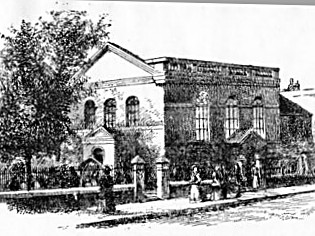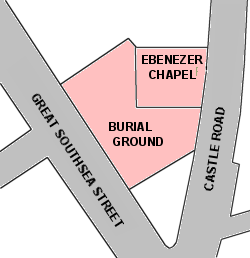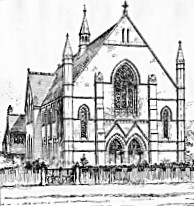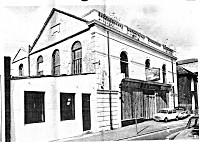
The Baptists are known to have had a presence in Portsmouth since the early 1640s. Records show that the first pastor was a Mr. Wentworth, who was followed by Richard Drinkwater and then Thomas Bowes. Up until the passing of the Toleration Act in 1688, when dissenters were protected from persecution, the Baptists had been forced to meet in secret, but on the enactment of the legislation Thomas Bowes gave a parcel of land in the garden of his property in St. Thomas's Street on a lease of 99 years.
Around 1700 Bowes began to subscribe to the Socinian view and converted the first church to one supporting Unitarianism. Many of his congregation left to form their own mainstream Baptist church, meeting initially in a barn on Portsmouth Common. In 1704 Edward Parsons bought some land in West Dock Field and used part of it to build a Meeting House which had seating for up to 200 people. It was built of stone obtained from the demolition of Netley Abbey and was known as Meeting House Alley, later Kent Street Baptist Chapel. In 1730 the congregation had raised sufficient funds to buy the chapel and in 1750 extended in to include a Baptistery. Prior to that date baptisms were carried out at Milton Farm, in the moat around Portsmouth or in the great morass on Southsea Common.
The beginning of the 19th century saw five more chapels spring from the congregation at Meeting House Alley. They were at Green Row (1800), Forton, Gosport (1807), the Ebenezer Chapel in Castle Road (1811), Salem St., White Swan Fields (1813) and Lake Lane. The dates differed slightly when a list of chapels was published in The Baptist Magazine for 1827.

The Ebenezer Chapel
Initially known as the chapel at Southsea Common, the Ebenezer chapel was formed by members of Meeting House Alley who felt that the new town of Southsea needed it's own place of worship. It was opened on Sunday 22nd January 1809 by Reverend D. Miall and Reverend J. Ivemey but it took a further two years before an official licence for a church was granted by the Bishop of Winchester. The Ebenezer chapel itself was not completed until 1812/13 by which time an adjacent parcel of land had been purchased for use as a burial ground. On 12th March 1813 Mr. John Headden was inducted as pastor of the chapel with Mr. John Clay as his assistant.
According to the historians Henry and Julian Slight, the building cost £1900 and that much of the wooden interior came from French ships captured during the Napoleonic Wars.

The fact that the Ebenezer chapel had its own burial ground was highly significant, for up until the time it was brought into use dissenters were forced to bury their dead in Church of England graveyards, either with rites of which they disapproved or in total silence. It was in use from 1815 but we have figures for the number of burials in the years 1827, 1828 and 1829 only, when according to the Slights there were 62, 25 and 25 interments respectively. The unique nature of the cemetery only lasted until 1831 when the Portsea Island General Cemetery was opened at Mile End where there were no requirements for burial services.
Although the burial ground remained in operation after the opening of Mile End Cemetery it's days were numbered and in 1854 the Burial Ground Act forced local authorities to bury their dead outside the main areas of habitation. Portsmouth Borough Council opened Highland Road Cemetery in November 1854 and burials at the Ebenezer chapel ceased. Before it closed however it had accepted the mortal remains of Reverend John Clay and Reverend John Headdon.
With it's closure the cemetery rapidly became overgrown, with the exception of the Headdon family vaults which were cared for by the Newton brothers. Soon there was talk of building a Temperance Hall on the burial ground and a head high wall was constructed around the plot. The Newton brothers took kindly to neither and mounted a series of nightime raids to break holes in the walls and fill in the foundation trenches. At one point the chapel authorities managed to raise the walls of the hall to a height of 20 ft but once again the Newtons managed to demolish the structure. In the end they won and the project to build the hall was abandoned.

The Ebenezer chapel itself continued in use until 1892, when, following a disastrous fire at the Kent Street chapel it was decided that a new place of worship should be found in central Southsea and that the few remaining members of the Ebenezer congregation would join it. On 11th April 1892 the Immanuel church was formed and met at Victoria Hall. Numbers rose steadily and by the end of the century a new building was being raised following the laying of foundation stones on April 18th 1899. The new building was to be known as the Immanuel Baptist Church and Schools and it was sited in Victoria Road North. The first pastor was the Reverend John Kemp who had also been the last pastor of the Ebenezer chapel.

The Immanuel church was destroyed by German bombs on the night of January 10th 1941, but a new modern structure took its place after the war. The Ebenezer church fell into disrepair and was used as a garage from 1920, but despite attempts to save it as the last part of Portsmouth's Baptist heritage it was demolished in 1979 and the land was redeveloped for housing. During the digging of the foundations for the residential units many bones were recovered but nowhere near as many as should have been expected from the probable number of burials that must have taken place there.
References
The Ebenezer Baptist Chapel Southsea by Heather H. Taylor
"Immanuel" - A souvenir
The Evening News